
TẠP CHÍ KHOA HỌC VÀ CÔNG NGHỆ, Trường Đại học Khoa học, ĐH Huế
Tập 23, Số 1 (2023)
75
DESIGN AND NUMERICAL INVESTIGATION ON A PASSIVE MICRO T-MIXER
WITH TAIL-ADDED OBSTACLES
Phu Nguyen Van1, Van-Anh Bui1, Thanh Pham Van1, Quynh Luu Manh2,
Nam Nguyen Hoang3, Tien Nguyen Chung4, Van Nguyen Thi Thanh4*
1 Faculty of Physics, VNU University of Science, Vietnam National University, Hanoi
2Center for Material of Science, VNU University of Science, Vietnam National University, Hanoi
3Nano and Energy Center, VNU University of Science, Vietnam National University, Hanoi
4Vietnam Academy of Cryptography Techniques
*Email: nguyenthithanhvancms@gmail.com
Received: 16/11/2022; Received in revised form: 17/11/2022; Accepted: 4/8/2023
ABSTRACT
In this paper, the type of obstacle micromixer model was designed and investigated
by numerical simulation to improve the mixing efficiency. Passive mixers with tail-
added obstacles structures were studied and compared with other conventional T
microstructures, and then their mixing performance was numerically evaluated. The
micro-T mixer with tail-added obstacles (µTTAO) exhibited a higher mixing
efficiency and reached 87.2%. In addition, the concentration range at the outlet was
also narrow, the mixing efficiency was increased by about 1.41 compared with the
normal micro-T mixer. The combination of grooves greatly enhances the mixing in
the flow path due to strong turbulence. The combination of multiple tracks in the
fluidic structure enhances the micromixer's performance by reducing mixing time.
In addition, the influence of the length and number of obstacles in the microchannel
has also been studied extensively. This study shows that increasing the number or
length of obstacles in the microchannel optimally improves the mixing efficiency
value. The results further demonstrated that going beyond the performance of the
micro-T mixer with obstacles, the µTTAO is a potential structure for optimizing the
mixing quality of the micro-T mixer. This study is a significant turning point with
high efficiency and low cost in the future.
Keywords: Grooves; Mixing simulation; Passive mixer; T-shaped channel.

Design and numerical investigation on a passive micro T-mixer with tail-added obstacles
76
1. INTRODUCTION
In the past decade, various instruments in the field of microfluidics have been
developed for the analysis of biological and chemical targets in the research areas of
biomedical diagnostics, food safety control, and environmental protection. Microfluidic
use in various applications has received increasing attention due to its compact size,
automatic operation, faster detection, fewer reagents, higher sensitivity, and integration
capability [1]–[6]. Studies typically integrate injection, mixing, reacting, washing,
separation, and detection onto a centimeter-level chip [7]. In the research field of
biological, chemical, or medical reaction processes, many reagents must be mixed before
a reaction can occur. The mixing process must be rapid and even so that the reaction can
develop fully, and the reaction dynamics can be studied. Among them, micromixers are
one of the most important components of micro-scale fluid devices, which significantly
affect the performance and sensitivity of fluid systems.
Micromixer is one of the most important components of a microfluidic device
where the mixing of fluids becomes critical, like in reagents such as small molecules,
large macromolecules, and particles. At the micro-scale, the mixing process often
depends on convection effects and achieves heat and mass transfer efficiency. Due to the
small dimensions and high surface–to–volume ratio, the micro-scale fluidic devices
present unique and very different physical mechanisms compared to the macroscopic
ones. In addition, the mixing efficiency is also significantly dependent on the molecular
diffusion mechanism, which is a slow process and may require microchannel stretching
to achieve the desired mixing quality [8]. Therefore, the mixing efficiency can be
considered a key parameter for a micromixer and one of the most fundamental
challenges.
Based on the principles used to perform the mixing process at the microscale,
micromixers are generally classified into two types: passive micromixers and active
micromixers. Active micromixers use actuators to improve mixing efficiency by stirring
liquid flow using external forms of energy supply such as electrokinetic time pulsed [5]–
[7], [9], magnetic field and heat, and pressure perturbation [10]. Active mixer
construction usually requires an external power source, such as an electric field,
magnetic field, and sound. In contrast, passive micromixers require no external power
input except the power to drive fluids and commonly used complex channel geometries
to enhance turbulent diffusion or convection. The active micromixers’ structure is
usually relatively simple and easier to control, but the requirements of external energy
sources make it harder for them to assimilate. Passive mixers are much easier integrated
into microfluidic devices, but they often require complex fabrication processes to create
the desired structure. The passive micromixer relies on its geometry to enhance the
mixing efficiency and has strong system stability, so it was widely used in microfluidic

TẠP CHÍ KHOA HỌC VÀ CÔNG NGHỆ, Trường Đại học Khoa học, ĐH Huế
Tập 23, Số 1 (2023)
77
systems. Among them, the T-shaped passive micromixers structure is more
straightforward to manufacture than other passive micromixers because of its simple
geometry.
In this study, the micromixer with tail-added obstacles model is designed and
investigated by numerical simulation to improve mixing efficiency. The design of the
proposed mixing structure utilizes twisted microchip systems to increase the fluid
transfer inside the fluidic channel. The tail-added obstacles were intentionally added
along the microchannel to increase turbulent advancement and facilitate the mixing
process. Passive mixers with tail-added obstacles structures were studied and compared
with other conventional T microstructures. In addition, the tail length and the number
of tail-added obstacles which increase the mixing channel performance were also
studied, simulated, and calculated.
2. MIXING STRUCTURE
The basic design of a micro-T mixer is a passive micromixer with two inputs and
one output, as shown in Fig. 1 (a). The main channel was designed with a length of 800
μm and a width of 100 μm. The width of the inlet microchannels was equal to 50 μm.
The micro-T mixer was added with 11 obstacles in the main channel, as shown in Fig. 1
(b), to improve the mixing efficiency compared to the normal channel. The obstacles
were tilted at an angle of 45 degrees to the vertical and designed to be 50√2 μm in length.
Fig. 1. Mixing Geometry of two fluids in a micro-T mixer (a) without and (b) with obstacles

Design and numerical investigation on a passive micro T-mixer with tail-added obstacles
78
Fig. 2. Mixing Geometry of two fluids in a µTTAO
In this study, we propose a micro-T mixer with tail–added obstacles (µTTAO),
which was designed similarly to the conventional micro-T mixer with obstacles and
added tails. Each tail was designed with a length of 20 μm, as shown in Fig. 2.
3. SIMULATION
3.1 Model Parameters and Physics
In this work, the numerical simulation was performed in COMSOL Multiphysics
5.6 software. The mass transport and fluid flow equations are simulated with suitable
boundary conditions. The finite element method was used to solve those equations.
The T-mixer model was designed with two inputs fed by different concentrations
of 1 M and 0 M, respectively. Blood and water, two low-diffusivity liquids, were used
and analyzed in the simulation. The properties of the fluids are shown in Table 1.
Table 1. Fluid and physical properties are used in the simulation model [11].
Properties
Value
Unit
Blood density
1060
kg/m3
Blood viscosity
4
mPa·s
Water density
1000
kg/m3
Water viscosity
1
mPa·s
Diffusivity
7.55×10−11
m2/s
Velocity
3×10−4
m/s
The diffusivity of blood and water, D is calculated using the Stokes-Einstein
Equation [12]:

TẠP CHÍ KHOA HỌC VÀ CÔNG NGHỆ, Trường Đại học Khoa học, ĐH Huế
Tập 23, Số 1 (2023)
79
𝐷= 𝐾𝑇
6𝜋𝜂𝑅1𝑚2/𝑠
(1)
Where K is the Boltzmann constant (1.38×10−23𝐽/𝐾), T is the temperature (K), 𝑅1 is the
radius of the molecule of solute (m), 𝜂 is the viscosity of the solvent (𝑃𝑎.𝑠). The
diffusivity, D, is calculated as 7.55×10−11 𝑚2/𝑠.
The inlet of the channel was fed a liquid flow with a velocity of 3×10−4 m/s
while the outlet of the channel was set at a pressure of 0 Pa. At the microchannel wall,
the boundary condition was no slip for fluid velocity and impermeability of ions. The
corresponding equations are:
𝑢=0
(2)
𝑛.𝐽𝑖=0
(3)
Where u is the velocity (𝑚/𝑠), 𝐽 is the flux density of species i.
The other physical properties used in the simulation are shown in Table I. A set
of physical interfaces in the microfluidic channel was designed to examine the
simulation model. In 2D modeling, physical models such as laminar flow and transport
of diluted species were applied.
3.2 Governing Equation
In this study, the velocity and pressure of liquid flow in the channel were
simulated with laminar channel conditions. Specifically, in this case, the Navier - Stokes
equation is solved for an uncompressed stream in the time domain [13]:
𝜌(𝜕𝑢
𝜕𝑡+𝑢.𝛻𝑢)=−𝛻𝑝+𝛻.𝜇𝛻𝑢
(4)
∇.𝑢=0
(5)
Where 𝑢 is the local velocity (𝑚/𝑠), 𝜌 is the pressure (𝑃𝑎), 𝜇 is the liquid viscosity (𝑃𝑎.𝑠),
and −∇𝑝 is the pressure gradient.
For co-laminar flow, diffusion is dominant in mixing and is defined as the
process by which a molecule propagates in a channel from an area of higher
concentration to an area of lower concentration. The description of diffusion is governed
by Fick's Law [14]:
𝑁𝑖=−𝐷𝑖∇𝑐𝑖
(6)
𝜕𝑐𝑖
𝜕𝑡=𝐷𝑖∇2𝑐𝑖
(7)
Where 𝑁𝑖,𝐷𝑖 and 𝑐𝑖 is the molar flux (mol.m−2.s−1), diffusion coefficient (m2.s−1) and
the concentration (mol.m−3), respectively.




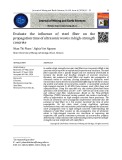
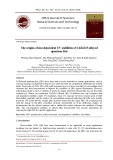
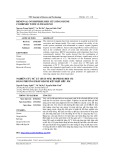
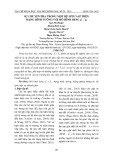
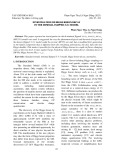
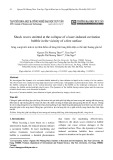
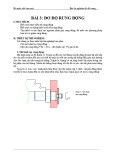









![Bộ câu hỏi lý thuyết Vật lý đại cương 2 [chuẩn nhất/mới nhất]](https://cdn.tailieu.vn/images/document/thumbnail/2025/20251003/kimphuong1001/135x160/74511759476041.jpg)
![Bài giảng Vật lý đại cương Chương 4 Học viện Kỹ thuật mật mã [Chuẩn SEO]](https://cdn.tailieu.vn/images/document/thumbnail/2025/20250925/kimphuong1001/135x160/46461758790667.jpg)




